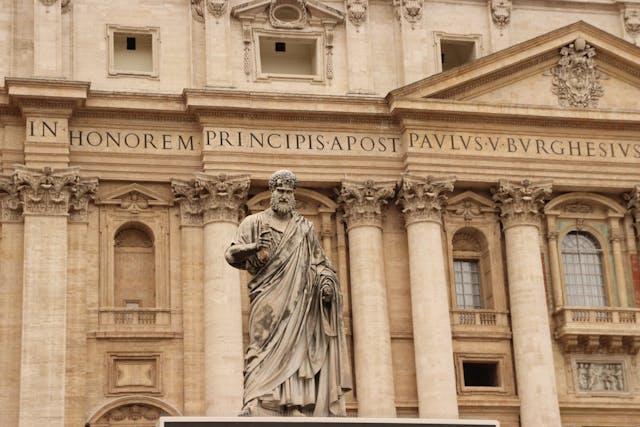Saint Peter, originally named Simon, was renamed by Jesus to signify his foundational role in the Church—’You are Peter, and on this rock I will build my Church’ (Matthew 16:18). As the first pope, his legacy endures at the heart of Vatican tradition.
The first American pope honors the legacy of St. Leo the Great and Leo XIII in name and mission, signaling a papacy of strength and renewal.
VATICAN CITY — When white smoke curled above the Sistine Chapel and Cardinal Robert Francis Prevost of Chicago was introduced to the world as the new pope, another key moment quickly followed. With centuries of tradition and symbolism behind him, he declared the name he had chosen for his papacy: Leo XIV.
It was a name both familiar and bold—one that called back centuries of Catholic history while casting a vision for a renewed Church in a modern, uncertain age.
Why Popes Change Their Names
The tradition of adopting a new papal name began in 533 AD, when Pope John II—born Mercurius—chose to abandon his birth name, which honored a Roman god. Since then, nearly every pope has followed suit, selecting a name that reflects spiritual priorities, theological orientation, or a tribute to a past leader or saint.
More than a symbolic gesture, the choice of name represents a spiritual rebirth, much like biblical renamings—Saul to Paul, Simon to Peter. It signals the beginning of a new mission: to lead the world’s 1.3 billion Catholics not as an individual, but as the spiritual successor of St. Peter.
Names can communicate continuity, reform, humility, or strength. In choosing Leo, Pope Leo XIV intentionally steps into the legacy of two towering figures in Church history.
A Name Steeped in Strength
The Latin Leo, meaning “lion,” evokes courage, protection, and leadership. Thirteen previous popes have carried the name, but none more influential than St. Leo the Great and Pope Leo XIII.
Saint Leo the Great (440–461 AD)
Leo I led the Church during the collapse of the Western Roman Empire. He is perhaps best known for turning back Attila the Hun in 452, persuading the invader to spare the city of Rome—a rare moment of spiritual diplomacy in history.
But Leo’s greatest legacy lies in doctrine. His Tome of Leo, affirmed at the Council of Chalcedon, defined Christ as fully human and fully divine—a cornerstone of Christian belief. Leo also reinforced the primacy of the papacy, establishing the role of the Bishop of Rome as a unifying authority across the Christian world. For these reasons, he is one of only two popes honored with the title “the Great” and is recognized as a Doctor of the Church.
Pope Leo XIII (1878–1903)
More than a millennium later, Pope Leo XIII would guide the Church into the modern age. Born Vincenzo Pecci, he issued the landmark encyclical Rerum Novarum in 1891, defending workers’ rights and launching what would become known as Catholic social teaching—a tradition of advocacy for justice, dignity, and economic ethics.
Leo XIII also emphasized intellectual renewal, promoting the study of St. Thomas Aquinas and reaffirming the compatibility of faith and reason. His papacy is remembered for engaging with the challenges of industrialization and secularization while maintaining theological clarity.
The First American Pope—and a New Chapter
By taking the name Leo XIV, the new pope places himself within a powerful lineage of strength, clarity, and reform. His election as the first American-born pontiff is historic. Raised in Chicago and shaped by years of missionary service in Peru, Pope Leo XIV inherits a Church that is both expanding in the Global South and facing secular decline in much of the West.
While his name choice does not reference a contemporary figure, its symbolism is rooted in history. St. Leo the Great defended Rome and defined doctrine during a time of upheaval. Pope Leo XIII brought the Church into modern social thought with conviction and compassion.
By choosing the name Leo, the new pope signals a connection to this tradition—invoking strength in doctrine, moral leadership in crisis, and thoughtful engagement with the world.
His papacy begins not with novelty, but with resonance. In a time of global change, Pope Leo XIV has embraced a name that speaks to courage, intellect, and the enduring mission of the Church.
What’s in a Name?
When the Cardinal Protodeacon stepped out onto the balcony of St. Peter’s Basilica and proclaimed, “Habemus Papam… qui sibi nomen imposuit Leo Quartus Decimus”—“We have a pope… who has taken the name Leo the Fourteenth”—he did more than reveal a title. He revealed a vision.
In this lion-hearted name is a tribute to Church history, a message to the faithful, and a quiet promise: that strength and service can walk together. That substance matters. And that the Church, in the hands of Pope Leo XIV, may find its roar once more.






